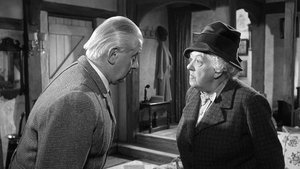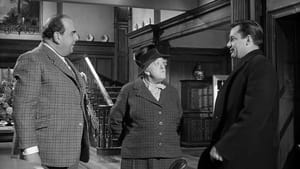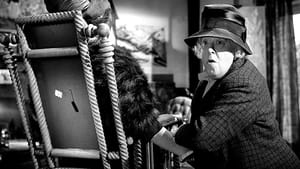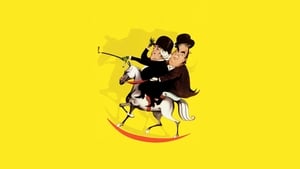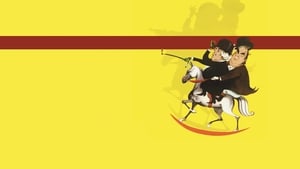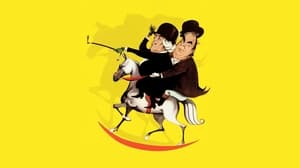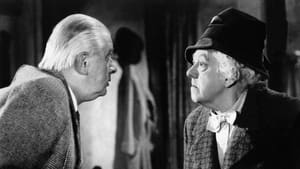Contact: info@alwanfilm.com
Video Sources 0 Views
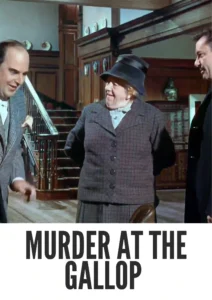
Synopsis
Review: Murder at the Gallop 1963 Colorized – A Charming Whodunit in Agatha Christie’s Classic Style

Introduction
“Murder at the Gallop,” a 1963 British mystery film, stands as one of the beloved adaptations of Agatha Christie’s timeless detective stories. Directed by George Pollock, this film brings to life one of Christie’s most endearing characters, Miss Marple, played by the incomparable Margaret Rutherford. Set in a quaint English countryside, the film combines mystery, humor, and a touch of suspense, all while remaining faithful to the cozy atmosphere typical of Christie’s work. In this article, we will explore the charm and appeal of “Murder at the Gallop,” its faithful adaptation of Christie’s novel, and its significance within the genre of classic whodunits.
Check The Full Colorized Movies List
Check Our Colorized Movies Trailer Channel
Understanding Murder at the Gallop 1963 Colorized: Director, Cast, and Genre
“Murder at the Gallop” is part of a series of films based on Agatha Christie’s mysteries, all featuring Margaret Rutherford as the indomitable Miss Marple. Directed by George Pollock, who helmed several other Marple adaptations, the film is an adaptation of Christie’s novel “After the Funeral,” although with significant changes, including the substitution of Miss Marple for Christie’s other famous detective, Hercule Poirot.
Margaret Rutherford’s portrayal of Miss Marple is a highlight of the film, as she brings a unique blend of wit, charm, and determination to the role. Unlike the frail and reserved Marple of the novels, Rutherford’s Marple is energetic, sharp, and unafraid to get directly involved in the investigation. This character shift made Rutherford’s interpretation beloved by audiences, even if it strayed somewhat from Christie’s original depiction.
Supporting Rutherford, the cast includes Robert Morley as Hector Enderby, Flora Robson as Miss Milchrest, and Stringer Davis as Mr. Stringer, Miss Marple’s loyal companion. The film’s genre is a classic whodunit, characterized by its suspenseful plot, red herrings, and the gradual unveiling of the murderer, all set against the backdrop of the genteel English countryside.
Exploring the World of Murder at the Gallop 1963 Colorized: Plot and Characters
“Murder at the Gallop” begins with Miss Marple and Mr. Stringer collecting donations for charity when they visit the home of an elderly man, Mr. Enderby. After witnessing a suspicious encounter, Miss Marple soon finds herself embroiled in a murder mystery. Mr. Enderby dies suddenly, and although his death is initially attributed to natural causes, Miss Marple suspects foul play.
As the investigation unfolds, Miss Marple’s suspicions are confirmed when she discovers that Mr. Enderby’s death was indeed murder, and she suspects the killer is someone within his close circle. To uncover the truth, she infiltrates a local riding school, the Gallop Hotel, where she mingles with the suspects, each with their own secrets and potential motives.
The film excels in its character development, as each suspect is vividly portrayed, making them all plausible culprits. Hector Enderby, Mr. Enderby’s nephew, is a jovial but self-serving man with a keen interest in the family inheritance. Miss Milchrest, a stern and secretive woman, appears to be hiding something crucial. The interplay between these characters, combined with Miss Marple’s astute observations, keeps the audience guessing until the very end.
The Art of Film Adaptation
Adapting a novel into a film is always a challenge, particularly when the source material is as beloved as Agatha Christie’s mysteries. “Murder at the Gallop” takes certain liberties with the original novel, “After the Funeral,” most notably replacing Hercule Poirot with Miss Marple as the protagonist. This change, while significant, does not detract from the film’s success. Instead, it allows the story to be told from a different, yet equally compelling, perspective.
Film adaptations often require a condensation of plot and characters to fit within a standard runtime, and “Murder at the Gallop” is no exception. However, the film retains the essence of Christie’s storytelling—its intricate plot, memorable characters, and satisfying resolution—while adding a layer of humor and warmth that makes it a delightful cinematic experience.
Early Detective Films: A Brief History
The detective genre has been a staple of cinema since the early days of filmmaking. From the silent film era to the golden age of Hollywood, mystery and detective films have captivated audiences with their suspenseful plots, clever detectives, and elaborate crimes. Early detective films often drew inspiration from popular literature, including the works of Edgar Allan Poe, Arthur Conan Doyle, and, of course, Agatha Christie.
These films laid the groundwork for the genre, establishing tropes that continue to be used in modern mystery cinema. The eccentric detective, the locked-room mystery, the red herrings, and the dramatic reveal are all elements that have their roots in these early films. “Murder at the Gallop” is part of this rich tradition, contributing its own unique flavor to the genre.
Murder at the Gallop 1963 Colorized and Its Place in Cinema History
“Murder at the Gallop” holds a special place in the history of detective cinema, not only as an adaptation of Agatha Christie’s work but also as a film that helped define the on-screen persona of Miss Marple. Margaret Rutherford’s portrayal of the character became iconic, influencing subsequent interpretations of the role and endearing her to audiences worldwide.
The film’s release in 1963 came during a period when British cinema was experiencing a resurgence, with a renewed interest in literary adaptations and period pieces. “Murder at the Gallop” stood out for its charming blend of mystery and humor, setting it apart from the more serious thrillers of the time. Its success led to three more films in the series, all starring Rutherford as Miss Marple, further cementing her place in the annals of cinematic history.
The Debate Over Film Adaptations
As with any adaptation of a beloved novel, “Murder at the Gallop” sparked discussions among fans and critics about the merits and pitfalls of altering the source material. While some purists lamented the replacement of Hercule Poirot with Miss Marple, others appreciated the film’s fresh take on the story and Rutherford’s delightful performance.
This debate is not unique to “Murder at the Gallop”; it is a common occurrence whenever a popular book is adapted for the screen. The challenge lies in balancing the expectations of fans of the original work with the creative liberties necessary to translate the story into a different medium. In the case of “Murder at the Gallop,” the film successfully walks this fine line, delivering a thoroughly entertaining mystery that pays homage to Christie’s genius while offering something new to audiences.
Examining Murder at the Gallop 1963 Colorized as a Classic Whodunit
“Murder at the Gallop” exemplifies the classic whodunit genre, with its carefully constructed plot, eccentric characters, and the gradual unveiling of the truth. The film invites viewers to play detective alongside Miss Marple, piecing together clues and trying to identify the murderer before the final reveal.
The film’s pacing is deliberate, allowing the tension to build as Miss Marple uncovers each new piece of evidence. The use of humor, particularly through Rutherford’s performance, adds a lightness to the film, making it a pleasant watch even as the mystery deepens. The film’s setting, a charming English village and a countryside riding school, provides the perfect backdrop for this genteel mystery, steeped in the traditions of classic British detective fiction.
Influence and Legacy: Murder at the Gallop 1963 Colorized’s Impact on Cinema
“Murder at the Gallop” and the other films in the Rutherford-Marple series have had a lasting impact on how Agatha Christie’s work is adapted for the screen. Rutherford’s portrayal of Miss Marple has become iconic, influencing subsequent adaptations and setting a standard for how the character is depicted.
The film also contributed to the popularity of the cozy mystery genre in cinema, where the focus is less on graphic violence and more on the intellectual puzzle of solving the crime. This approach has been emulated in countless films and television shows since, from “Murder, She Wrote” to “Father Brown,” all of which owe a debt to the groundwork laid by “Murder at the Gallop.”
Director’s Cinematic Legacy: Beyond Murder at the Gallop 1963 Colorized
George Pollock, the director of “Murder at the Gallop,” was a key figure in bringing Agatha Christie’s work to the screen during the 1960s. In addition to “Murder at the Gallop,” he directed three other Miss Marple films starring Margaret Rutherford: “Murder She Said” (1961), “Murder Most Foul” (1964), and “Murder Ahoy!” (1964). These films established Pollock as a skilled director of mystery films, known for his ability to balance suspense with light-hearted humor.
Pollock’s work on the Marple series was instrumental in shaping the visual and tonal style of future Christie adaptations. His ability to create a cozy, engaging atmosphere while maintaining the tension of the mystery was a significant achievement, and his influence can be seen in many later adaptations of Christie’s work, both on film and television.
Themes Explored in Murder at the Gallop 1963 Colorized
“Murder at the Gallop” explores several themes typical of Agatha Christie’s mysteries, including the deceptiveness of appearances, the complexities of human relationships, and the nature of justice. The film also touches on themes of greed and inheritance, as the motive for murder is often tied to the desire for wealth and power.
The theme of deception is central to the film, as characters present false fronts and hide their true intentions. Miss Marple, with her keen observational skills and deep understanding of human nature, is able to see through these deceptions and uncover the truth. The film also examines the idea of justice, with Miss Marple ensuring that the guilty party is brought to account, even when the official authorities are slow to act.
Reception and Controversy Surrounding Murder at the Gallop 1963 Colorized
Upon its release, “Murder at the Gallop” was well-received by both audiences and critics, who praised Margaret Rutherford’s performance and the film’s engaging plot. However, there was some controversy among Christie purists, particularly regarding the decision to replace Hercule Poirot with Miss Marple. Despite these concerns, the film was a box office success and has remained a favorite among fans of classic mystery cinema.
The film’s reception highlights the challenges of adapting beloved literary works, particularly when changes are made to the source material. While some viewers appreciated the film’s humor and Rutherford’s unique take on Miss Marple, others felt that the film strayed too far from Christie’s original vision. Nonetheless, “Murder at the Gallop” has endured as a beloved entry in the canon of Agatha Christie adaptations.
Where to Watch MMurder at the Gallop 1963 Colorized Online
For those interested in experiencing the charm and intrigue of “Murder at the Gallop,” the film is available on various streaming platforms. Whether revisiting this classic or watching it for the first time, viewers can enjoy this delightful whodunit from the comfort of their own homes.
The film is often included in collections of Agatha Christie adaptations, available for purchase or rental on platforms like Amazon Prime Video, iTunes, and Google Play. Additionally, fans of classic British cinema may find the film on specialty streaming services that focus on vintage films and television.
FAQs About Murder at the Gallop 1963 Colorized
Q: Is “Murder at the Gallop” a faithful adaptation of Agatha Christie’s novel “After the Funeral”?
A: While “Murder at the Gallop” is based on “After the Funeral,” it makes significant changes to the story, most notably replacing Hercule Poirot with Miss Marple as the main detective. However, the film retains the essential elements of Christie’s plot, including the mystery and the investigation of a suspicious death.
Q: How does Margaret Rutherford’s portrayal of Miss Marple differ from the character in the books?
A: Margaret Rutherford’s Miss Marple is more energetic and assertive than the character in Christie’s novels, where Miss Marple is depicted as a quieter, more introspective figure. Rutherford’s interpretation added a humorous and lively dimension to the character, making her a favorite with audiences, even if it deviated from Christie’s original portrayal.
Q: What other films feature Margaret Rutherford as Miss Marple?
A: Margaret Rutherford played Miss Marple in four films directed by George Pollock: “Murder She Said” (1961), “Murder at the Gallop” (1963), “Murder Most Foul” (1964), and “Murder Ahoy!” (1964). These films are loosely based on Agatha Christie’s novels and are known for their light-hearted tone and Rutherford’s distinctive performance.
Conclusion
“Murder at the Gallop (1963)” is a delightful entry in the pantheon of classic British mystery films. With its charming countryside setting, engaging plot, and memorable performances—especially by Margaret Rutherford as the indomitable Miss Marple—the film continues to enchant audiences more than half a century after its release. Though it takes liberties with its source material, the film remains true to the spirit of Agatha Christie’s storytelling, offering viewers a satisfying whodunit with a dash of humor.
As we reflect on the legacy of “Murder at the Gallop,” it’s clear that the film has left an indelible mark on the genre of detective cinema. Its success paved the way for future adaptations of Christie’s work and helped solidify Margaret Rutherford’s place in cinematic history as one of the most beloved portrayals of Miss Marple. Whether watching it for the first time or revisiting it as an old favorite, “Murder at the Gallop” offers a timeless mystery that continues to entertain and intrigue, proving that the appeal of a good whodunit never fades.
